To make a beige color from gouache you will need several dyes for mixing. Using 2-3 basic dyes and a drop of additional colors, you get light shades of brown with different saturation and temperature. Mixing gouache or other dyes is used when the desired shade is not in the paint set or has run out on the palette.
Characteristics and shades
You can make a beige color if you use standard or light brown as the main color. White, cream, yellow or other additional gouache dyes are added to it.
In psychology, beige is considered a color that evokes a feeling of comfort. The human consciousness perceives it well, as familiar in everyday life, similar to the color of the skin. Shades of beige evoke calm and stable emotions.
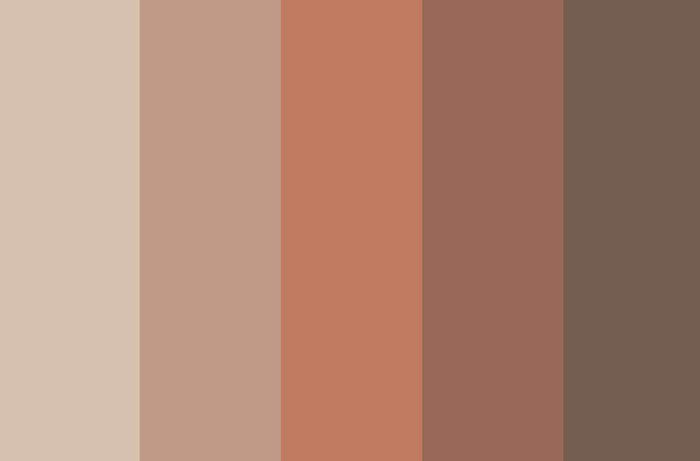
Beige is used in various fields – from painting to design work. Its tones are neutral, they are used as a background or as an accent in details. Decorators and artists do not recommend using only this color in work, even in different shades, so that all the elements do not merge.
There are several basic shades of beige.
| Name | How to get |
| Wheat | Mix 2 parts white and 1 part each yellow and red. |
| Cream | Mix red and yellow in equal proportions. Lighten with white and add a drop of blue. |
| Dark beige | Mix red and green in equal proportions. |
| Sand | Mix white and brown in equal proportions.
Green, black and red are added drop by drop. |
| Ivory | Mix 2 parts white paint and 1 part gold. |
| Light caramel | Mix white and orange in a ratio of 1:2. |
| Light coffee | Mix 1 part red and 1 part yellow. Add a drop of violet. |
Mixing rules
You can make beige from gouache by mixing the two components of the dye on a palette mechanically, like most other dyes. For most liquid paints, mixing beige follows the same pattern with a difference in time, since thick oil paints require a longer mixing time.
Before starting the process of combining paints, prepare everything you need:
- paints from which the color and shade will be made;
- a palette or surface for mixing dyes;
- brushes and stirring sticks;
- container with water (for water-soluble paints);
- draft to check tone.
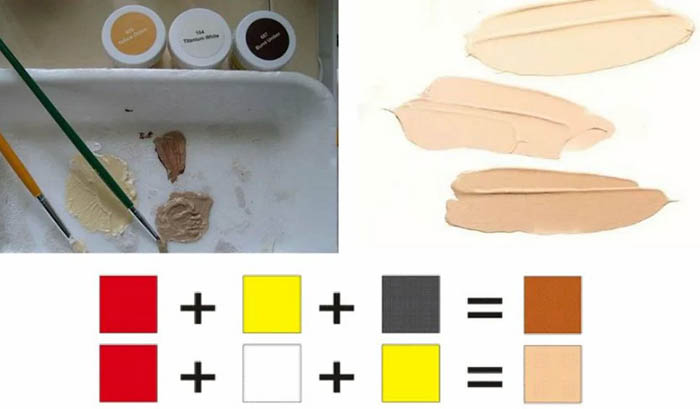
Follow the rules of mixing paints so that the process takes less time and the result is obtained the first time.
- The components of the paint are applied to the palette one by one in the required proportions.
- It is recommended to use different brushes for each paint color so that they do not mix anywhere except on the palette.
- The palette should be white to avoid optical illusion.
- If you are mixing water-soluble paints, rinse the brush in water each time before picking up a new color.
- Test the finished paint mixture on a rough copy and wait for the brushstrokes to dry, as most dyes change saturation after drying.
- It is recommended to mix paints of only one type.
From the primary colors
You can make beige from gouache in different shades - from cream to yellow, adding different auxiliary colors. You can mix not only gouache, but also other paints - acrylic, watercolor, oil and even solid dyes, like pencils or plasticine.
Each of the dyes has its own characteristics in the mixing process, but the basic proportions of the constituent colors remain the same. The main colors used are white and brown or ocher, where white predominates. Additional colors (yellow, blue, red) are added in smaller quantities to obtain a new tone.
Classical
Standard beige is made by mixing 2 parts white and 1 part brown. Add a little yellow if desired.
There are other schemes for obtaining a classic shade.
- Combine brown with yellow, add a little red and white.
- Mix yellow with white and a drop of pink.
- Mix yellow, red and blue. Dilute with a large amount of white.
- Mix 1 part ochre and 2 parts white. Add a drop of red for a warm shade or a drop of green for a cool tone.
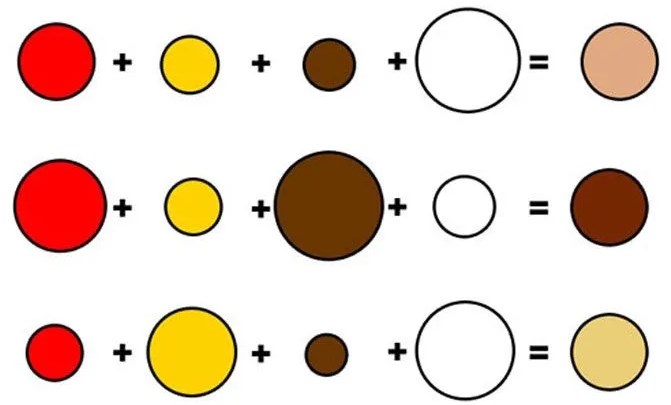
The finished mixture is always checked on a rough copy and allowed to dry to compare the saturation of the tone with the mixture of paints. If necessary, the mixture of paints is darkened with a drop of black or lightened with a drop of white paint.
Dark beige
To obtain a dark shade of beige, mix 3 parts of white, 1 part of caramel color and a drop of green. Mix all the ingredients thoroughly until you get a medium beige color. To darken the shade, add more green and a drop of black.
Different shades of dark beige are obtained by lightening brown, obtained according to the scheme:
- black and brown;
- brown and red;
- brown and yellow;
- yellow and blue;
- red and blue.
Light beige
To obtain light shades of beige, mix brown with white and a drop of yellow. White paint is added more than the others, yellow is slightly less, brown is used in small quantities as a base color. Another option for obtaining a light beige shade is to mix ochre, white and a drop of brown.
From paints and materials of different types
You can make beige from gouache or other types of paint by mixing them manually on a palette. Most often, brown, gold, green, red and white paints are required. If desired, other colors can be added to obtain new shades. Prepare a palette or clean container if you need to mix paints in large quantities.
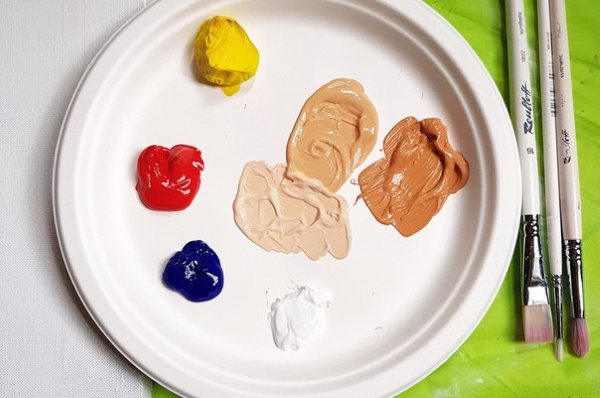
Prepare several brushes, paper or other surface to be painted, and a rough surface to test the tone.
Gouache
Making beige from gouache is easier than from most dyes, as the water-soluble paint is easy to work with and is suitable for most decorative works. This paint dries quickly, has no unpleasant odor, the colors are easy to combine with each other, but it is not recommended to combine more than 3 colors in one mixture to avoid a muddy undertone.
Gouache is mixed if the color palette is out of the desired color or if there is no suitable shade.
The process of mixing gouache to obtain a beige color is as follows.
- Prepare the necessary: a set of paints, brushes, a container with water, a palette and a draft. Use a white palette or other surface for mixing paints to avoid color distortion.
- The brush is dipped in water, then in paint. If one of the paints has dried out, it is first diluted with water to a semi-liquid state.
- Brown paint is applied to the palette. Then white is added, this color will be needed in greater quantities, but the exact proportion is determined independently depending on the desired result. The proportions can also change due to the different density of the dye, which can be dissolved in water.
- If you need to lighten the tone, add white or a little water to the mixture, which can remove the saturation by 1-2 tones. Too much white dye in the composition can make the tone cold.
- If you want to make the tone darker, add a drop of black paint or a little brown dye. Black paint should be added carefully, as it absorbs the color strongly and makes the tone dirty.
- If necessary, add other additional colors to achieve the desired shade.
- Make a test stroke on the draft and leave it for a while for the paint to dry. Gouache tends to change saturation after drying. Compare the color of the paint on the draft and the mixture of paints. If necessary, add the desired paint.
- Once the desired color is obtained, they begin painting. If gouache is applied to paper, then rough sheets are chosen, on which the dye lies better. The first layer is applied with vertical strokes, the next one – horizontal. All layers of paint are applied without waiting for drying. If the first layer is unsuccessful, the second layer can completely cover it, if the paints were not diluted with water in large quantities.
Acrylic paints
Mix acrylic paints to get a beige color for any decorative work. This is a universal bright dye, which is sold in ready-made sets with pure color or in separate jars or tubes. If the desired shade of beige is not available, resort to mixing paints.
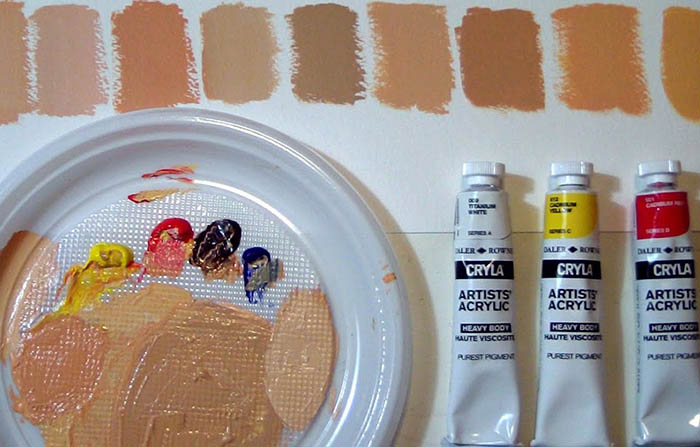
The process goes as follows.
- A little brown or ochre paint is applied to the palette.
- Add a small amount of white dye and mix thoroughly to avoid streaks. Add white paint until the desired shade of beige is obtained.
- The resulting tone is lightened or darkened with white or black paint.
- If necessary, add a small amount of additional dye to obtain a new color undertone.
- The resulting color is checked by making a smear on the draft and leaving it to dry. The paint may change and become paler, then additional paints are added to the mixture.
- Once the desired tone has been achieved, painting begins.
Watercolor
Watercolor paints are easy to mix, but to get beige combine the colors carefully, trying to maintain a balance between the paints and the water base, otherwise the color will turn out too faded:
- Prepare paints, a container of water, a palette and paper on the work table. Work on a white palette to track the color change.
- The brush is dipped in water, then in paint. Each time, the brush is thoroughly washed, so it is recommended to take a larger container for water so that the solution remains clean longer.
- Brown is applied to the palette and white is gradually added until the desired shade of beige is obtained. If there is no brown, yellow, pink and white are combined in small doses so as not to spoil the mixture. Try to mix no more than 3-4 colors so that the finished tone is not dirty.
- Add black or white paint to darken or lighten beige. You can lighten the tone with water, but then it loses its saturation.
- They check that the color retains its saturation after drying and, if necessary, add more paint to the mixture.
Oil paints
Getting beige by mixing oil paints is more difficult than with other dyes because of the thickness. You can use the most common method - mechanical mixing on a palette, as is done when working with watercolors, gouache or acrylic. The original colors are brown and white, other colors can be added in small quantities.
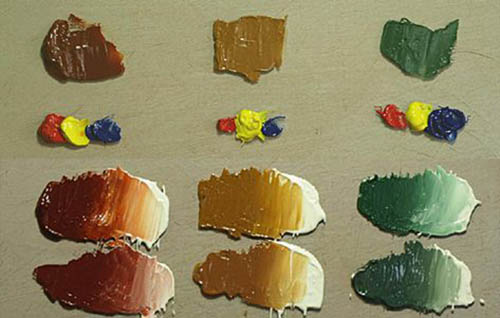
More experienced artists mix paints using complex methods - they apply a thin layer of white paint on top of brown paint directly on the canvas. It is possible to achieve a beige tone optically, when the brown shows through the transparent white tone.
The third method is also achieved by an optical method, when the paints are not mixed, but applied directly to the canvas close to each other and in one direction. A special spatula is used for this.
Pencils
Mixing pencil colors, you won't be able to achieve a pure beige color because of the wax included in the composition. It prevents pigments from mixing, but different methods of applying shading allow you to get a color close to beige.
You can get different shades of beige by mixing colors:
- brown and white;
- peach, pink and white;
- yellow, red and white;
- orange, pink and white.

Use only pencils of one type. Depending on the order of applying the colors, the final shade of beige may change. Apply strokes of different colors on top of each other in one direction, in a cross direction, or make close hatching, creating an optical effect of mixing colors.
Apply each color with a little pressure so that you can monitor the depth of the color as you go. Once the desired tone is achieved, blend with your finger, eraser, or piece of paper.
Plasticine
Plasticine can be mixed to create new colors and shades just like other dyes. Because of its thick consistency, the mixing process takes much longer.

First, warm up the color components in your hands.
- Knead the white plasticine.
- Gradually add pieces of brown (or red), yellow and orange plasticine. The white mass should be more than 1.5 times.
- Mix the mass until smooth. To do this, knead the mass into a flat cake, fold it in half and repeat this several times.
Felt-tip pens
To make beige from gouache, mix brown and white paints mechanically. To achieve the same effect with felt-tip pens, lighten the brown with a zero marker or mix sand, yellow and red colors from light to dark.
The mixing process is done in circular motions and they try not to combine more than 3 colors. The markers are mixed quickly before they dry. After drying, the tone becomes lighter.
Video about color mixing
How to get beige color by mixing paints:
